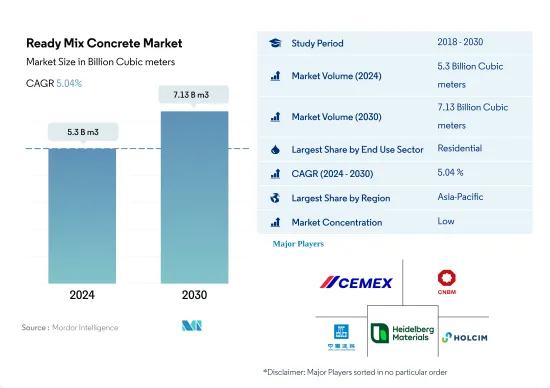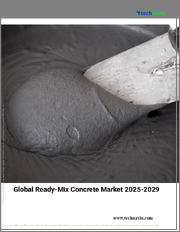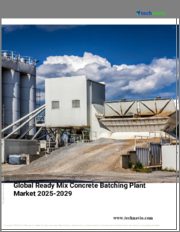
|
시장보고서
상품코드
1687287
세계의 레디믹스 콘크리트 시장 : 점유율 분석, 산업 동향과 통계, 성장 예측(2025-2030년)Ready Mix Concrete - Market Share Analysis, Industry Trends & Statistics, Growth Forecasts (2025 - 2030) |
||||||
■ 보고서에 따라 최신 정보로 업데이트하여 보내드립니다. 배송일정은 문의해 주시기 바랍니다.
세계의 레디믹스 콘크리트 시장 규모는 2024년 53억 입방미터로, 2030년에는 71억 3,000만 입방미터에 이를 것으로 예측되며, 예측기간 중(2024-2030년) CAGR 5.04%로 성장할 전망입니다.

주택 수요 증가가 레디믹스 콘크리트 시장의 성장을 견인할 것 같습니다.
- 2022년, 레디믹스 콘크리트의 세계 소비량은 전년 대비 약 5.46% 감소했고, 이는 주로 주택과 상업 건설 부문 수요가 약해졌기 때문입니다. 특히 주택 부문에서는 2022년의 신 설상면적이 2021년 대비 1.05% 감소했습니다.
- 주택 부문은 레디믹스 콘크리트 최대의 소비자이며, 2022년의 세계 소비량의 약 36.96%를 차지하고 있습니다. 말레이시아 정부는 2025년까지 약 50만 호의 저렴한 주택을 건설하는 것을 목표로 하고 있습니다.
- 상업 부문은 예측 기간 동안 6.34%의 현저한 CAGR로 레디믹스 콘크리트 소비자의 급성장을 예측합니다. 쇼핑몰, 오피스 및 기타 상업지구에 대한 수요가 증가함에 따라 2023년 68억 3,000만 평방피트에 이르는 세계 업무용 신설 바닥 면적이 예상됩니다. 예를 들어, 인도의 상위 7개 도시에 있는 A 등급 오피스 시장은 2026년까지 약 10억 평방 피트로 확대되고, 2030년까지 12억 평방 피트로 확대될 것으로 보입니다. 그 결과, 상업 부문에서 레디믹스 콘크리트의 세계 소비량은 2030년까지 2023년 대비 394입방미터 증가할 것으로 예측됩니다.
아시아태평양과 중동 및 아프리카에서 급증한 건설 활동이 레디믹스 콘크리트 수요를 견인할 것 같습니다.
- 레디믹스 콘크리트는 시멘트, 물, 골재(모래, 자갈 등), 혼화제의 혼합물입니다. 기초, 벽, 바닥, 차도 등 다양한 건설 용도에 사용하기 위해 정확하게 혼합됩니다. 2022년 시장은 전년 대비 약 5.46%의 하락을 경험했는데, 이는 주로 주택 부문 수요 하락으로 인한 것이었습니다. 구체적으로 주택부문은 2021년에 비해 2022년에는 약 13.04%의 하락을 보였습니다. 그러나 시장은 회복되어 2023년에는 2022년 대비 약 5.06%의 성장이 예측됩니다.
- 세계 소비를 선도하는 아시아태평양은 2022년에 레디믹스 콘크리트 시장의 약 74.66%를 차지했습니다. 7개 도시의 A 등급 오피스 시장은 2026년까지 약 10억 평방 피트, 2030년까지 추가로 12억 평방 피트까지 확대할 것으로 보입니다.
- 소비의 프론트 러너로서 부상하고 있는 중동 및 아프리카는 예측 기간 중에 레디믹스 콘크리트 시장에서 5.68%의 최고의 CAGR을 나타낼 것으로 예상되고 있습니다. 특히, 사우디아라비아는 야심적인 계획을 가지고 있으며, 2030년까지 약 55만 5,000호의 주택, 430만 평방미터 이상의 소매 공간, 610만 평방미터 이상의 새로운 오피스 공간의 추가를 목표로 하고 있습니다.
세계의 레디믹스 콘크리트 시장 동향
아시아태평양의 대규모 오피스 빌딩 건설 프로젝트가 급증하고 세계 상업시설 건설 바닥 면적 증가
- 2022년 세계 상업시설의 신설 바닥 면적은 전년 대비 0.15%의 소폭 성장이 되었습니다. 종업원의 사무실 복귀에 따라, 유럽 기업은 리스 계약을 재개해, 2022년에는 450만 평방 피트의 신규 오피스 건설에 박차를 가했습니다.
- COVID-19의 유행은 노동력과 자재 부족을 일으켜 상업시설 건설 프로젝트의 취소와 지연을 초래했습니다.
- 향후 세계 상업시설의 신설 바닥 면적의 CAGR은 4.56%가 될 것입니다. 중국, 인도, 한국, 일본의 상업시설 건설 프로젝트의 활성화입니다. 인도에서는 2023-2025년까지 상위 7개 도시에서 약 2,325만 평방 피트에 달하는 약 60개의 쇼핑몰이 오픈할 예정입니다. 아시아태평양 전역의 이러한 대처를 합계하면, 2030년까지 상업시설의 신규 바닥 면적은 2022년 대비 15억 6,000만 평방 피트 증가할 것으로 예상됩니다.
세계 주택 부문을 뒷받침하는 저렴한 주택 계획에 대한 정부 투자 증가로 남미 주택 건설이 가장 빠르게 성장할 것으로 추정됩니다.
- 2022년 세계 주택건축의 신규 바닥면적은 2021년 대비 약 2억 8,900만 평방피트 감소했습니다. 2021년 대비 5.39% 감소했습니다. 그러나 2023년에는 2030년까지 30억 명을 수용할 수 있는 저렴한 주택을 새로 건설하기 위한 자금을 조달할 수 있는 정부 투자로 세계 신설 바닥 면적은 2022년 대비 3.31% 증가할 것으로 보여 밝은 전망이 예측됩니다.
- COVID-19의 유행은 경기 감속을 일으켜, 그 때문에 많은 주택 건설 프로젝트가 중지 또는 연기되어 2020년 세계의 신설 바닥 면적은 2019년에 비해 4.79% 감소했습니다. 주택 프로젝트에 대한 우울한 수요가 해방되자, 신설 바닥 면적은 2020년 대비 11.22% 증가하고, 유럽이 18.28%로 가장 높은 성장을 나타내고 이어 남미가 2021년에 2020년 대비 17.36% 증가했습니다.
- 세계의 주택용 신설 바닥 면적은 예측 기간 동안 CAGR 3.81%를 나타낼 것으로 예측되며, 남미가 가장 빠른 CAGR 4.05%로 발전할 것으로 예측됩니다. 2023년 발표된 브라질의 Minha Casa Minha Vida와 같은 계획 및 이니셔티브는 몇 가지 규제 변경과 함께 발표되었으며, 정부는 저소득 가구에 저렴한 주택을 제공하기 위해 19억 8000만 달러의 투자를 계획하고 있습니다. 2023년에 발표된 칠레의 FOGAES와 같은 계획이나 이니셔티브는 저렴한 주택을 위해 가족에게 모기지를 제공하는 것을 목적으로 하고 있어 새로운 주택의 건설을 촉진합니다.
레디믹스 콘크리트 산업 개요
레디믹스 콘크리트 시장은 세분화되어 있으며 상위 5개 기업에서 6.24%를 차지하고 있습니다.
기타 혜택
- 엑셀 형식 시장 예측(ME) 시트
- 3개월의 애널리스트 서포트
목차
제1장 주요 요약과 주요 조사 결과
제2장 보고서 제안
제3장 소개
- 조사의 전제조건과 시장 정의
- 조사 범위
- 조사 방법
제4장 주요 산업 동향
- 최종 용도 부문의 동향
- 상업
- 산업 및 시설
- 인프라
- 주택용
- 주요 인프라 프로젝트(현재 및 발표된 것)
- 규제 프레임워크
- 밸류체인과 유통채널 분석
제5장 시장 세분화
- 최종 용도 부문
- 상업
- 산업 및 시설
- 인프라
- 주택용
- 제품
- 센트럴 믹스
- 수축 믹스
- 트랜짓 믹스
- 지역
- 아시아태평양
- 국가별
- 호주
- 중국
- 인도
- 인도네시아
- 일본
- 말레이시아
- 한국
- 태국
- 베트남
- 기타 아시아태평양
- 유럽
- 국가별
- 프랑스
- 독일
- 이탈리아
- 러시아
- 스페인
- 영국
- 기타 유럽
- 중동 및 아프리카
- 국가별
- 사우디아라비아
- 아랍에미리트(UAE)
- 기타 중동 및 아프리카
- 북미
- 국가별
- 캐나다
- 멕시코
- 미국
- 남미
- 국가별
- 아르헨티나
- 브라질
- 기타 남미
- 아시아태평양
제6장 경쟁 구도
- 주요 전략 동향
- 시장 점유율 분석
- 기업 상황
- 기업 프로파일
- BBMG Corporation
- Buzzi SpA
- CEMEX, SAB de CV
- China National Building Material Group Corporation
- CRH
- CSCEC
- Foshan Huijiang Concrete Co., Ltd.
- Heidelberg Materials
- Holcim
- OYAK Cement
- SAMPYO GROUP
- Shanghai Construction Group(SCG)
- UltraTech Cement Ltd.
- Vicat
- Votorantim Cimentos
제7장 CEO에 대한 주요 전략적 질문
제8장 부록
- 세계 개요
- 개요
- Porter's Five Forces 분석 프레임워크(산업 매력도 분석)
- 세계의 밸류체인 분석
- 시장 역학(DROs)
- 정보원과 참고문헌
- 도표 일람
- 주요 인사이트
- 데이터 팩
- 용어집
The Ready Mix Concrete Market size is estimated at 5.3 billion Cubic meters in 2024, and is expected to reach 7.13 billion Cubic meters by 2030, growing at a CAGR of 5.04% during the forecast period (2024-2030).

Increasing demand for housing units is likely to drive the ready-mix concrete market's growth
- In 2022, the global consumption of ready-mix concrete saw a decline of approximately 5.46% from the previous year, primarily due to weakened demand from the residential and commercial construction sectors. Notably, the residential sector saw a 1.05% decrease in new floor area in 2022 compared to 2021. However, a rebound was expected in 2023, with ready-mix concrete consumption projected to grow by around 5.06% globally.
- The residential sector stands as the largest consumer of ready-mix concrete, accounting for nearly 36.96% of the global consumption in 2022. Factors such as urbanization, government initiatives, and both foreign and domestic investments are fueling housing demands, leading to an uptick in residential construction. For instance, Germany announced its plans to construct a minimum of 4,000 new housing units by 2024. Similarly, the Malaysian government aims to build around 500 thousand affordable housing units by 2025. Consequently, ready-mix concrete consumption in the residential sector is projected to surge by 32.39% by 2030 compared to 2023.
- The commercial sector is projected to be the fastest-growing consumer of ready-mix concrete, with a notable CAGR of 6.34% during the forecast period. The global commercial new floor area was anticipated to reach 6.83 billion sq. ft in 2023, driven by heightened demand for shopping malls, offices, and other commercial spaces. For instance, India's grade A office market in its top seven cities is set to expand to approximately 1 billion sq. ft by 2026 and further to 1.2 billion sq. ft by 2030. Consequently, the global consumption of ready-mix concrete in the commercial sector is projected to increase by 394 cubic meters by 2030 compared to 2023.
Fast-paced construction activities in Asia-Pacific and Middle East & Africa are likely to drive the demand for ready-mix concrete
- Ready-mix concrete is a blend of cement, water, aggregates (such as sand or gravel), and admixtures. It is precisely mixed for use in diverse construction applications like foundations, walls, floors, and driveways. In 2022, the market experienced a downturn of approximately 5.46% compared to the previous year, largely due to a dip in demand from the residential sector. Specifically, the residential sector saw a decline of about 13.04% in 2022 compared to 2021. However, the market was projected to rebound, with a growth of around 5.06% in 2023 compared to 2022.
- Leading the global consumption, Asia-Pacific accounted for roughly 74.66% of the ready-mix concrete market in 2022. The region's robust demand is fueled by its burgeoning population, rapid urbanization, and heightened construction activities. Notably, investments in industrial, healthcare, and commercial sectors, including retail and offices, are on the rise. For instance, India's grade A office market in its top seven cities is set to expand to approximately 1 billion sq. ft by 2026 and further to 1.2 billion sq. ft by 2030. As a result, the Asia-Pacific ready-mix concrete market is poised for a significant surge, with a projected growth of about 42.28% by 2030 compared to 2023.
- Emerging as the frontrunner in consumption, Middle East & Africa is anticipated to register the highest CAGR of 5.68% in the ready-mix concrete market during the forecast period. This growth is primarily driven by escalating demand in both the residential and commercial segments. Notably, Saudi Arabia has ambitious plans, aiming to add approximately 555 thousand residential units, over 4.3 million sq. m of retail space, and more than 6.1 million sq. m of fresh office space by 2030.
Global Ready Mix Concrete Market Trends
Asia-Pacific's surge in large-scale office building projects is set to elevate the global floor area dedicated to commercial construction
- In 2022, the global new floor area for commercial construction witnessed a modest growth of 0.15% from the previous year. Europe stood out with a significant surge of 12.70%, driven by a push for high-energy-efficient office buildings to align with its 2030 carbon emission targets. As employees returned to offices, European companies, resuming lease decisions, spurred the construction of 4.5 million square feet of new office space in 2022. This momentum is poised to persist in 2023, with a projected global growth rate of 4.26%.
- The COVID-19 pandemic caused labor and material shortages, leading to cancellations and delays in commercial construction projects. However, as lockdowns eased and construction activities resumed, the global new floor area for commercial construction surged by 11.11% in 2021, with Asia-Pacific taking the lead with a growth rate of 20.98%.
- Looking ahead, the global new floor area for commercial construction is set to achieve a CAGR of 4.56%. Asia-Pacific is anticipated to outpace other regions, with a projected CAGR of 5.16%. This growth is fueled by a flurry of commercial construction projects in China, India, South Korea, and Japan. Notably, major Chinese cities like Beijing, Shanghai, Hong Kong, and Taipei are gearing up for an uptick in Grade A office space construction. Additionally, India is set to witness the opening of approximately 60 shopping malls, spanning 23.25 million square feet, in its top seven cities between 2023 and 2025. Collectively, these endeavors across Asia-Pacific are expected to add a staggering 1.56 billion square feet to the new floor area for commercial construction by 2030, compared to 2022.
South America's estimated fastest growth in residential constructions due to increasing government investments in schemes for affordable housing to boost the global residential sector
- In 2022, the global new floor area for residential construction declined by around 289 million square feet compared to 2021. This can be attributed to the housing crisis generated due to the shortage of land, labor, and unsustainably high construction materials prices. This crisis severely impacted Asia-Pacific, where the new floor area declined 5.39% in 2022 compared to 2021. However, a more positive outlook is expected in 2023 as the global new floor area is predicted to grow by 3.31% compared to 2022, owing to government investments that can finance the construction of new affordable homes capable of accommodating 3 billion people by 2030.
- The COVID-19 pandemic caused an economic slowdown, due to which many residential construction projects got canceled or delayed, and the global new floor area declined by 4.79% in 2020 compared to 2019. As the restrictions were lifted in 2021 and pent-up demand for housing projects was released, new floor area grew 11.22% compared to 2020, with Europe having the highest growth of 18.28%, followed by South America, which rose 17.36% in 2021 compared to 2020.
- The global new floor area for residential construction is expected to register a CAGR of 3.81% during the forecast period, with South America predicted to develop at the fastest CAGR of 4.05%. Schemes and initiatives like the Minha Casa Minha Vida in Brazil announced in 2023 with a few regulatory changes, for which the government plans an investment of USD 1.98 billion to provide affordable housing units for low-income families, and the FOGAES in Chile also publicized in 2023, with an initial investment of USD 50 million, are aimed at providing mortgage loans to families for affordable housing and will encourage the construction of new residential units.
Ready Mix Concrete Industry Overview
The Ready Mix Concrete Market is fragmented, with the top five companies occupying 6.24%. The major players in this market are CEMEX, S.A.B. de C.V., China National Building Material Group Corporation, CSCEC, Heidelberg Materials and Holcim (sorted alphabetically).
Additional Benefits:
- The market estimate (ME) sheet in Excel format
- 3 months of analyst support
TABLE OF CONTENTS
1 EXECUTIVE SUMMARY & KEY FINDINGS
2 REPORT OFFERS
3 INTRODUCTION
- 3.1 Study Assumptions & Market Definition
- 3.2 Scope of the Study
- 3.3 Research Methodology
4 KEY INDUSTRY TRENDS
- 4.1 End Use Sector Trends
- 4.1.1 Commercial
- 4.1.2 Industrial and Institutional
- 4.1.3 Infrastructure
- 4.1.4 Residential
- 4.2 Major Infrastructure Projects (current And Announced)
- 4.3 Regulatory Framework
- 4.4 Value Chain & Distribution Channel Analysis
5 MARKET SEGMENTATION (includes market size, forecasts up to 2030 and analysis of growth prospects.)
- 5.1 End Use Sector
- 5.1.1 Commercial
- 5.1.2 Industrial and Institutional
- 5.1.3 Infrastructure
- 5.1.4 Residential
- 5.2 Product
- 5.2.1 Central Mixed
- 5.2.2 Shrink Mixed
- 5.2.3 Transit Mixed
- 5.3 Region
- 5.3.1 Asia-Pacific
- 5.3.1.1 By Country
- 5.3.1.1.1 Australia
- 5.3.1.1.2 China
- 5.3.1.1.3 India
- 5.3.1.1.4 Indonesia
- 5.3.1.1.5 Japan
- 5.3.1.1.6 Malaysia
- 5.3.1.1.7 South Korea
- 5.3.1.1.8 Thailand
- 5.3.1.1.9 Vietnam
- 5.3.1.1.10 Rest of Asia-Pacific
- 5.3.2 Europe
- 5.3.2.1 By Country
- 5.3.2.1.1 France
- 5.3.2.1.2 Germany
- 5.3.2.1.3 Italy
- 5.3.2.1.4 Russia
- 5.3.2.1.5 Spain
- 5.3.2.1.6 United Kingdom
- 5.3.2.1.7 Rest of Europe
- 5.3.3 Middle East and Africa
- 5.3.3.1 By Country
- 5.3.3.1.1 Saudi Arabia
- 5.3.3.1.2 United Arab Emirates
- 5.3.3.1.3 Rest of Middle East and Africa
- 5.3.4 North America
- 5.3.4.1 By Country
- 5.3.4.1.1 Canada
- 5.3.4.1.2 Mexico
- 5.3.4.1.3 United States
- 5.3.5 South America
- 5.3.5.1 By Country
- 5.3.5.1.1 Argentina
- 5.3.5.1.2 Brazil
- 5.3.5.1.3 Rest of South America
- 5.3.1 Asia-Pacific
6 COMPETITIVE LANDSCAPE
- 6.1 Key Strategic Moves
- 6.2 Market Share Analysis
- 6.3 Company Landscape
- 6.4 Company Profiles
- 6.4.1 BBMG Corporation
- 6.4.2 Buzzi S.p.A
- 6.4.3 CEMEX, S.A.B. de C.V.
- 6.4.4 China National Building Material Group Corporation
- 6.4.5 CRH
- 6.4.6 CSCEC
- 6.4.7 Foshan Huijiang Concrete Co., Ltd.
- 6.4.8 Heidelberg Materials
- 6.4.9 Holcim
- 6.4.10 OYAK Cement
- 6.4.11 SAMPYO GROUP
- 6.4.12 Shanghai Construction Group(SCG)
- 6.4.13 UltraTech Cement Ltd.
- 6.4.14 Vicat
- 6.4.15 Votorantim Cimentos
7 KEY STRATEGIC QUESTIONS FOR CONCRETE, MORTARS AND CONSTRUCTION CHEMICALS CEOS
8 APPENDIX
- 8.1 Global Overview
- 8.1.1 Overview
- 8.1.2 Porter's Five Forces Framework (Industry Attractiveness Analysis)
- 8.1.3 Global Value Chain Analysis
- 8.1.4 Market Dynamics (DROs)
- 8.2 Sources & References
- 8.3 List of Tables & Figures
- 8.4 Primary Insights
- 8.5 Data Pack
- 8.6 Glossary of Terms
샘플 요청 목록



















